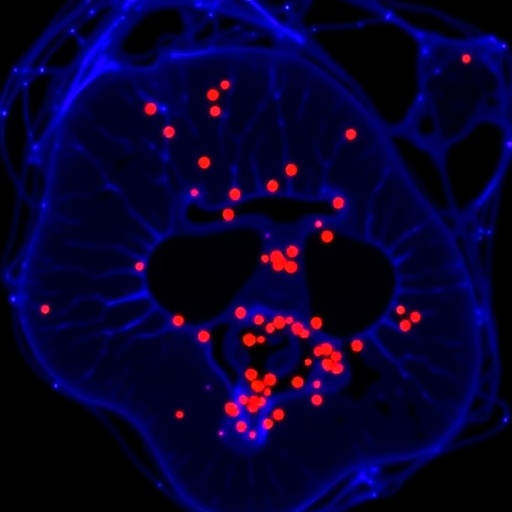
In the ever-evolving field of oncology, the intricate molecular mechanisms driving aggressive cancers continue to be a focal point of research. Osteosarcoma, a malignant bone tumor most frequently occurring in adolescents and young adults, poses significant therapeutic challenges due to its aggressive nature and metastatic potential. A groundbreaking study published recently by Liang, Tang, Chen, and colleagues reveals a pivotal role for the transcription factor NFATC3 in the exacerbation of osteosarcoma progression, specifically through the modulation of immune checkpoints and inflammatory chemokines. This discovery not only unravels new facets of osteosarcoma biology but also opens promising avenues for targeted therapeutic interventions.
Osteosarcoma is notorious for its rapid growth and propensity to metastasize, most commonly to the lungs, leading to poor patient prognoses. Despite advancements in chemotherapy and surgical techniques, the survival rate has stagnated over the past few decades, emphasizing the need to better understand the molecular underpinnings of this malignancy. Immunotherapy, which has revolutionized the treatment landscape for several cancers, remains underexplored and underutilized in osteosarcoma. The identification of molecules that enable tumor cells to evade immune surveillance is therefore crucial.
In this context, the study centers on NFATC3, a member of the Nuclear Factor of Activated T cells (NFAT) family of transcription factors. Traditionally recognized for their roles in immune cell function, NFAT proteins have garnered increasing attention for their contributions to tumor progression and metastasis across various cancers. Liang et al. demonstrate that NFATC3 expression is markedly upregulated in osteosarcoma tissue samples relative to normal bone, correlating strongly with increased tumor aggressiveness and poor clinical outcomes. This upregulation positions NFATC3 as a potential oncogenic driver in osteosarcoma.
.adsslot_XEd9zSB3ji{width:728px !important;height:90px !important;}
@media(max-width:1199px){ .adsslot_XEd9zSB3ji{width:468px !important;height:60px !important;}
}
@media(max-width:767px){ .adsslot_XEd9zSB3ji{width:320px !important;height:50px !important;}
}
ADVERTISEMENT
At the mechanistic level, NFATC3 appears to promote osteosarcoma progression by directly enhancing the expression of PD-L1 (Programmed Death-Ligand 1) and CXCL2, both pivotal molecules within the tumor microenvironment that facilitate immune escape and inflammation. PD-L1 serves as an immune checkpoint protein that binds to PD-1 receptors on cytotoxic T cells, effectively inhibiting their antitumor activity and allowing cancer cells to evade immune attack. The elevated expression of PD-L1, induced by NFATC3, essentially cloaks osteosarcoma cells, providing them with immunosuppressive capabilities that allow unchecked proliferation.
CXCL2, a chemokine primarily known for its role in recruiting neutrophils and modulating inflammation, also contributes to the establishment of a pro-tumorigenic microenvironment. Its overexpression, driven by NFATC3, can exacerbate inflammatory signaling pathways that favor tumor growth, angiogenesis, and metastasis. This dual enhancement of PD-L1 and CXCL2 expression by NFATC3 suggests a sophisticated mechanism wherein immune suppression and tumor-promoting inflammation act synergistically to facilitate osteosarcoma progression.
Crucially, the research team employed a suite of in vitro and in vivo approaches to dissect the functional significance of NFATC3 in osteosarcoma biology. In osteosarcoma cell lines, the knockdown of NFATC3 resulted in substantially decreased proliferation rates and invasive capabilities, underscoring its role in driving malignant phenotypes. Concurrently, lowered levels of PD-L1 and CXCL2 were observed, confirming the dependency of their expression on NFATC3 activity. Mouse models bearing osteosarcoma xenografts with silenced NFATC3 manifested reduced tumor growth and diminished metastatic colonization, solidifying the clinical relevance of their findings.
The implications of targeting NFATC3 extend beyond merely halting tumor growth. By downregulating PD-L1, the inhibition of NFATC3 could reinvigorate antitumor immune responses, enhancing T cell-mediated cytotoxicity. This positions NFATC3 as a tantalizing target that may potentially overcome resistance mechanisms to current immune checkpoint inhibitors, which have shown variable efficacy in osteosarcoma. Moreover, reducing CXCL2-mediated inflammatory cascades could disrupt the supportive tumor microenvironment, further limiting disease progression.
From a molecular signaling perspective, the researchers explored the upstream regulatory pathways that might control NFATC3 activation in osteosarcoma cells. They identified that calcium signaling and calcineurin phosphatase activity, known activators of NFAT family members, are likewise elevated in tumor samples. This suggests that osteosarcoma cells may exploit physiological immune signaling pathways, hijacking them to fuel malignancy. Pharmacological blockade of calcineurin effectively impaired NFATC3 nuclear translocation, offering a potential therapeutic strategy to curtail its oncogenic effects.
Beyond the canonical pathways, the study also provides insights into the interplay between NFATC3 and other oncogenic drivers within osteosarcoma cells. Transcriptomic analyses revealed that NFATC3 modulates a network of genes involved in apoptosis resistance, cell cycle progression, and extracellular matrix remodeling. This broad regulatory scope highlights NFATC3’s centrality in orchestrating the complex phenotypic traits that contribute to osteosarcoma malignancy.
Notably, the clinical relevance of these findings was bolstered by patient-derived tumor samples. High NFATC3 expression was consistently observed in aggressive, high-grade osteosarcomas and was associated with diminished overall survival, as analyzed through patient follow-up data. Such correlations reaffirm the potential utility of NFATC3 both as a prognostic biomarker and as a stratification tool to identify patients who might benefit from NFATC3-targeted therapies.
The translational potential of these discoveries cannot be overstated. Considering the limited efficacy of conventional treatments, integrating NFATC3 inhibition with current chemotherapy or emerging immunotherapeutic regimens could enhance patient outcomes. The modulation of tumor immune evasion mechanisms, coupled with the disruption of tumor-promoting inflammation, embodies a holistic approach to cancer therapy that transcends mono-targeted strategies.
Despite the compelling evidence, questions remain about the broader impact of NFATC3 inhibition on normal immune function, given the vital roles NFAT family members play in immune cell activation. Future studies will need to carefully dissect the balance between therapeutic efficacy and potential immunosuppressive side effects. Additionally, the development of specific inhibitors targeting NFATC3’s transcriptional activity or its upstream activators could be a challenging yet rewarding endeavor.
In conclusion, the work of Liang and colleagues delineates a novel axis by which NFATC3 accelerates osteosarcoma progression through the upregulation of PD-L1 and CXCL2. This not only enriches our molecular understanding of osteosarcoma pathogenesis but also illuminates innovative therapeutic landscapes. As the oncology community continues to seek breakthroughs against this formidable disease, NFATC3 stands out as a beacon of hope, promising to unlock new doors in the fight against osteosarcoma.
Subject of Research: Osteosarcoma molecular mechanisms and immune evasion
Article Title: NFATC3 enhances osteosarcoma progression by increasing PD-L1 and CXCL2 levels
Article References:
Liang, F., Tang, B., Chen, C. et al. NFATC3 enhances osteosarcoma progression by increasing PD-L1 and CXCL2 levels. Med Oncol 42, 388 (2025). https://doi.org/10.1007/s12032-025-02850-x
Tags: adolescent bone tumorschallenges in osteosarcoma treatmentCXCL2 and tumor progressionimmune checkpoints in cancer therapyimmunotherapy for bone cancermetastatic potential of osteosarcomamolecular mechanisms of osteosarcomaNFAT family proteinsNFATC3 role in osteosarcomatargeted interventions in cancer treatmenttherapeutic advancements in oncologytranscription factors in oncology





